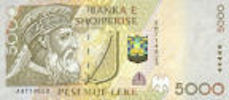Greek settlers of Apolonia and Dyrrhachium issued the first coins in present-day Albania in the fifth century BC. By the late first century BC, Albania was absorbed into the Roman Empire and its coins started to circulate. Byzantine coins circulated from the fall of the Roman Empire until the twelfth century when Ventian coins began to circulate.
Albania was part of the Ottoman Empire until it gained its independence on November 28, 1912. Albania was occupied by Italy beginning in 1938, and by Germany beginning in 1943 after Italy surrendered. Between January 11, 1946, when the People's Republic of Albania was founded, and April 30, 1991 when the Republic of Albania was declared, Albania was one of the most isolated countries on the planet. Albania was an autonomous state between 1912 and 1913, a principality between 1914 and 1925, a Republic between 1925 and 1928, a Kingdom between 1928 and 1939, under Italian occupation between 1939 and 1943, under German occupation between 1943 and 1944, an independent state between 1944 and 1945, a People's Republic between 1946 and 1991 and a Republic since 1991.
Albania used the Lira (XOTL) of the Ottoman Empire, which was divisible into 16 2/3 Altilik, 20 Beshlik, 33 1/3 Uechlik, 40 Yuzluk, 50 Ikilik, 100 Piastres/Kurush, 4000 Paras, 10,000 Minas or 12,000 Aspers. After the monetary reform of January 6, 1881, the Ottoman Empire Piastre (XOTP) was simplified and made divisible into 100 Piastres/Kurush and 4000 Paras.
After gaining its independence on November 28, 1912, coins of the Latin Monetary Union (XULF) from France, Italy and Greece, as well as Austria Kronen (ATK) circulated in Albania. Albania did not mint its own coins, or issue its own paper money until it adopted an independent monetary system on July 7, 1925 when Albania adopted the Franga (ALF) as its currency. The Franga (Franka Ari) was equal to 5 Lek, and divisible into 100 Qindar. The Franga was equal to the pre-war French silver Franc, making the Franga worth more than the French Franc since the Franc had depreciated during the war when France left the Gold Standard.
During World War II, the Albanian Franga was tied to the Italian Lira (XITL) at 1 ALF equal to 6.25 Italian Lira. When the Germans occupied Albania in 1943, German Reichskreditkassenschein notes (XDEK), equal to one German Reichsmark and 1.25 Albanian Franga, circulated in Albania. In November 1946, Albania formed a monetary union with Yugoslavia, setting the Yugoslav Dinar and the Albanian Lek at par with one another. Albania replaced the Franga with the Lek (ALK) at 5 Lek equal to 1 Franga. The Lek was subdivided into 100 Qindarka.
The monetary union was cancelled in June 1948 and Albania linked its currency to the Ruble with 1 Ruble equal to 12.5 Leks. When the Soviet Union reformed its currency on January 1, 1961, Albania followed suit, replacing the Albanian Lek with a “Heavy” Lek (ALL) equal to 10 old Lek. While Albania was an isolated socialist country, it had very few visitors, but it did issue Lek Foreign Exchange certificates (ALX) denominated in Lek. In 1992, Albania introduced the Lek Valute (ALV) equal to 50 Lek, but it is no longer used. The Lek was issued by the National Bank of Albania (Banka Combetare e Shqipnis) until 1945, by the State Bank of Albania (Banka e Shtetit Shqiptar) from 1945 until 1992, and by the Bank of Albania (Banka e Shqiperise) from 1992 on.


